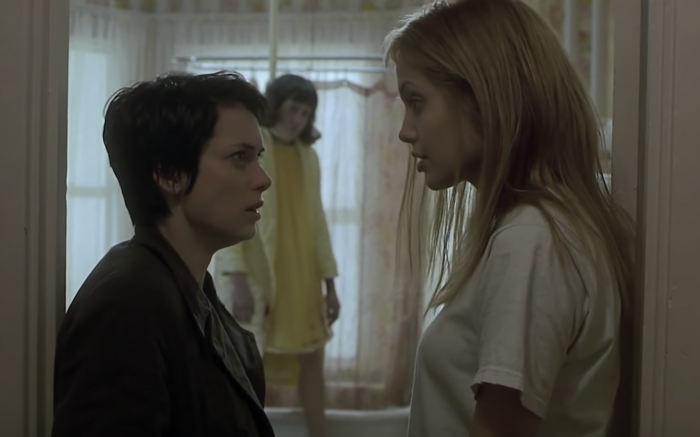We don’t say a lot about depression, but yep, I’m saying it.
I remember this day as if it’s frozen in time.
When people ask me what my rock bottom moment was, this is always my first thought.
It was picture day for my daughter in fifth grade in October 2011. I watched as she tried diligently to hide her prepubescent chest under a layer of clothing by adding a scarf. I had forgotten how young 10 was, and how uncomfortable. I watched her fuss, through the corner of my eye, but in the mirror, I saw a reflection of me—that thin, pale, shy, sweet, innocent, little girl I once was until her age, and the sexual abuse I experienced. I was a child.
The trigger had been pulled, and I froze.
That same morning one of my sons knocked a one-litre bottle of soda off the top shelf of the fridge, ping-ponging down off every shelf below before it hit the ground where it tumbled top over bottom across the floor, hitting the cupboard. I watched as he tried to catch it in its descent, falling in and out of his hands before he finally caught it.
He placed it on the countertop. Then he opened it. Its entire contents exploded all over the kitchen, and as hard as he tried to put the lid back on, it was impossible.
The soda was bottled and it blew up. It would never go back in the bottle.
That morning everything I had bottled up over the years blew up, and there was no means by which to siphon it back in.
All morning, I sat on the wood floor of my sun-soaked kitchen, my back up against the red signature wall that my husband had freshly painted, and I cried inconsolably. I had begun my descent into the abyss of Treatment-Resistant Major Depressive Disorder.
And those are the headlines—but it’s not the whole story.
Because even still, what I don’t spend much time discussing is what that type of depression looks like because truth be told it’s ugly.
I didn’t hit rock bottom and then suddenly bounce back up to greet life with a big ole smile on my face with a few doses of Prozac. It was a long process of slowly falling into a bottomless pit of blackness like the main character in the movie “Get Out,” and my only refuge to silence the visceral, terrifying flashbacks was sleep.
My mind, I suspect now in retrospect, was literally exhausted from the measures I had gone to for 20 years to hide from my past—the memories, the pain, the shame, the abuse, the violence, the terror, the dissociation and compartmentalization of those traumas and violations, both as a child and as an adult.
And so I slept for the better part of a year. I rose to get my children off to school, and then I went back to my bed and stayed there until someone came home. It was easy to blame lupus or my botched back surgeries.
A lupus flare-up, a long-standing, chronic source of physical pain, is allowed to last 15 months. Depression is not.
I knew depression. We had met at 16 as acquaintances. During my 20s, with postpartum depression, we became friends and I knew what it felt like to be in her life-sucking presence. But when she showed up in 2011, she attacked, leaving me beaten, bruised to the bone.
Everything hurt, not just my thoughts. My body and mind were raw, open, gaping burn wounds.
And what I didn’t know about depression at the time was how much potential it had to become a terminal illness. A family member had committed suicide, and I remember thinking that will never happen to me.
I tried a variety of different cocktails of medications until I needed them for everything: a pill to wake up, a pill to stop the panic attacks that landed me in an ambulance too many times to count, a pill to close the curtain of a real-life horror movie on the screen behind my forehead—to silence the nightmares and flashbacks that had taken over my nighttime.
I went 32 days without showering. Running the water to get the right temperature and popping open the cap to the shampoo bottle now required vice grips. Lathering body scrub, then having to climb back out and dry myself off, was exhausting. It was all exhausting just to think about.
I stopped eating. I just wasn’t ever hungry. That lump in my throat was growing, strangling both my voice box and my ability to swallow solid food. Within a year, my diet consisted of oatmeal, yogurt, and coffee, and I had stopped speaking much, if at all.
My then-husband was a garbage man and brought home bedbugs on his work clothes. I argued about getting a new mattress. I didn’t mind lying down with them biting at my arms and ankles. I didn’t want to be without a bed.
But we don’t talk about these things, do we? I’m supposed to be ashamed, and I was.
Because being in bed 18 hours a day is only acceptable when it’s a chronic autoimmune disease, and if it wasn’t a disease, someone you love may dare call you lazy or crazy or both.
Yes, it was that bad.
We moved from our dream home to a more modest one, thinking it would solve everything.
We do that don’t we? Buy another house, change the furniture, paint, renovate, take a vacation, change our job, our hair—anything—to fix it. Whatever it is, because it’s never the actual problem.
But a final blow to the gut, in August 2012, I fell through rock bottom’s trapdoor, and by this time, I had not left my house for months. I hadn’t driven in over a year.
This may sound extreme, but the thing is, it wasn’t. In fact, it’s pretty common.
We just don’t talk about it.
Yes, we have come a long way in tolerance and being politically correct, and gosh, I mean we even have commercials about antidepressants. We talk more openly about suffering from mental health struggles—vaguely, at least. We add a #metoo hashtag to our post, buy the purple ribbon for domestic violence, ink ourselves with a semicolon.
But what few are willing to talk about what that really looks like.
We think we are the exception to the rule and no one would ever understand.
So, let’s shove it back into the family box of secrets with everything else we have shoved in there since childhood, to protect our image. My God, what will people think?
See no evil, hear no evil, speak no evil. That’s how most families like it best: hide it, ignore it, don’t talk about it. Maybe, if we pretend there isn’t a problem, it will go away? Not a chance.
From a distance, we were the perfect family. But as well all know, what goes on behind closed doors is a whole other story.
One day, I had a moment of clarity in the wee hours of the night after watching the “Shawshank Redemption”:
“Get busy living or get busy dying.”
It scared me.
I went to my doctor, and when she asked how I was doing, I didn’t mince words. I wasn’t vague. I didn’t say, “I’m tired. I have no energy or interest in anything.”
I told her everything, the whole story, not just the headlines, and I left her office with a referral into a mental hospital.
Me, a former psychiatric nurse, now on the other side of the medication window and into the lineup of guests, waiting on the other side.
Oh, the irony. Life really does have a dark sense of humor, doesn’t it?
But the day I walked into that place, into that space, was the start of my healing.
I found myself in the presence of others, who, like me, had no safe place left to hide.
I’ve said it before, and I’ll say it again: The sanest people I’ve ever met were in the mental hospital.
They told the truth. They listened without judgement. They loved without conditions.
They saw me for who I was without my title, my label, my designation, or my many, many disguises and masks.
They welcomed me, Christina. Whoever that was.
I felt free for the first time in 42 years. I wish I could say I walked out of that hospital cured, but I didn’t.
Anyone who spends 56 days in the ICU with any other fragile medical condition leaves stabilized somewhat, but the pre-existing condition that brought one there does not miraculously disappear. This is health care not freaking magic!
In fact, I’ll be honest. It got a whole lot worse before it got better.
Again, for the people in the back, just like any other chronic illness. It would relapse and remiss, relapse and remiss. I found that the only way I would ever be healed was to address the things, people, and situations in my life that were toxic, slowly poisoning me, and leading me back into illness.
And let’s just be honest right here: that was what some wanted. They wanted me continuously relapsing into my mental illness. I was safer crazy than recovered! Oh, what might come out? Let’s just call her nuts and call it a day.
But much like having a heart attack, if you take your meds but refuse to change your lifestyle, diet, or stress levels, you don’t get better.
You are treating the symptoms but not the underlying factors that created them.
Nothing would change until I did.
I wrote all of it down, first in my journal, then I said it out loud.
I spoke it out of my body and into existence.
I chose to drop an atomic bomb of everything that had brought me to that point in my life and to open my mouth.
It wasn’t what anyone else had hoped for. They still had their bets on the right meds.
But what I did worked.
And that’s what I do every single day. I write and I speak to heal, not only for myself but also for others.
I advocate changing the narrative, in how we talk about mental health, as if the world is somehow under a delusion that the brain is not a part of the body when it is the damn command centre to so much, even wiggling your big toe.
I cannot choose the road you take to recovery. There are many roads to the same destination. My way is only one.
But what I know without a shadow of a doubt is that, in many regards, we are only as sick as the secrets we keep.
Shame is bred in silence, and shame shrinks in the light of truth. Stop feeding it!
Please, whatever someone has told you not to talk about. Talk about it.












Read 1 comment and reply